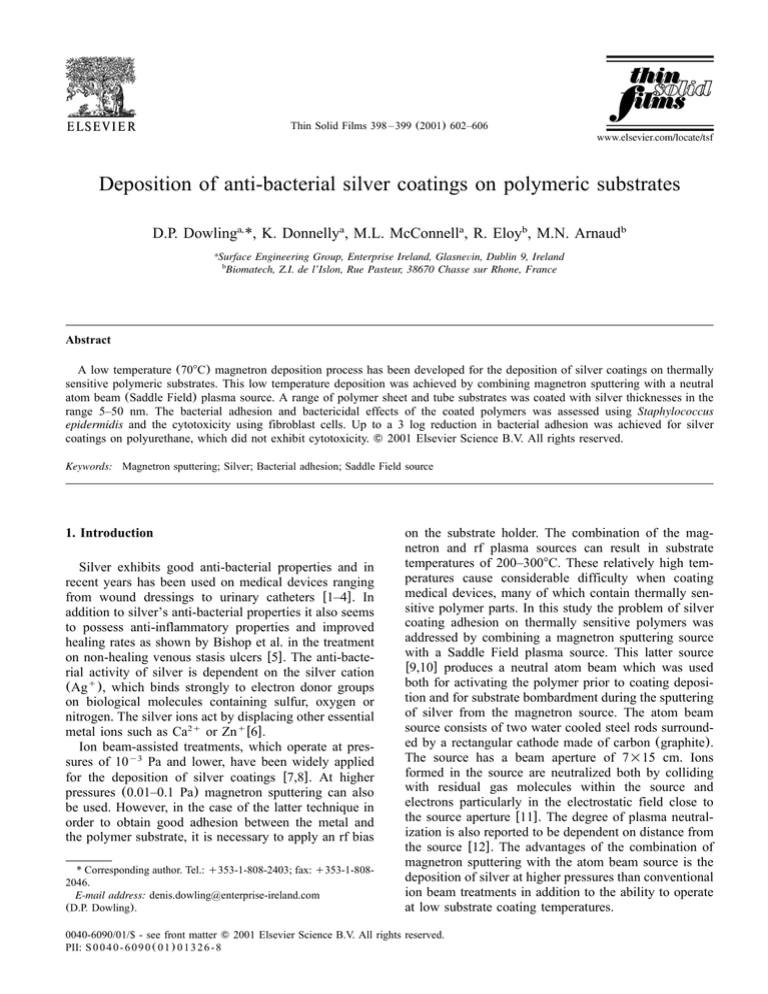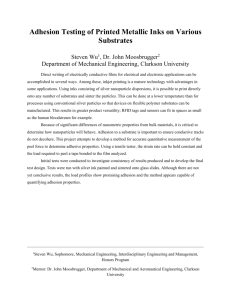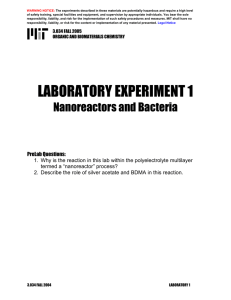
Thin Solid Films 398 – 399 (2001) 602–606
Deposition of anti-bacterial silver coatings on polymeric substrates
D.P. Dowlinga,*, K. Donnellya, M.L. McConnella, R. Eloyb, M.N. Arnaudb
a
Surface Engineering Group, Enterprise Ireland, Glasnevin, Dublin 9, Ireland
b
Biomatech, Z.I. de l’Islon, Rue Pasteur, 38670 Chasse sur Rhone, France
Abstract
A low temperature (708C) magnetron deposition process has been developed for the deposition of silver coatings on thermally
sensitive polymeric substrates. This low temperature deposition was achieved by combining magnetron sputtering with a neutral
atom beam (Saddle Field) plasma source. A range of polymer sheet and tube substrates was coated with silver thicknesses in the
range 5–50 nm. The bacterial adhesion and bactericidal effects of the coated polymers was assessed using Staphylococcus
epidermidis and the cytotoxicity using fibroblast cells. Up to a 3 log reduction in bacterial adhesion was achieved for silver
coatings on polyurethane, which did not exhibit cytotoxicity. 䊚 2001 Elsevier Science B.V. All rights reserved.
Keywords: Magnetron sputtering; Silver; Bacterial adhesion; Saddle Field source
1. Introduction
Silver exhibits good anti-bacterial properties and in
recent years has been used on medical devices ranging
from wound dressings to urinary catheters w1–4x. In
addition to silver’s anti-bacterial properties it also seems
to possess anti-inflammatory properties and improved
healing rates as shown by Bishop et al. in the treatment
on non-healing venous stasis ulcers w5x. The anti-bacterial activity of silver is dependent on the silver cation
(Agq), which binds strongly to electron donor groups
on biological molecules containing sulfur, oxygen or
nitrogen. The silver ions act by displacing other essential
metal ions such as Ca2q or Znqw6x.
Ion beam-assisted treatments, which operate at pressures of 10y3 Pa and lower, have been widely applied
for the deposition of silver coatings w7,8x. At higher
pressures (0.01–0.1 Pa) magnetron sputtering can also
be used. However, in the case of the latter technique in
order to obtain good adhesion between the metal and
the polymer substrate, it is necessary to apply an rf bias
* Corresponding author. Tel.: q353-1-808-2403; fax: q353-1-8082046.
E-mail address: denis.dowling@enterprise-ireland.com
(D.P. Dowling).
on the substrate holder. The combination of the magnetron and rf plasma sources can result in substrate
temperatures of 200–3008C. These relatively high temperatures cause considerable difficulty when coating
medical devices, many of which contain thermally sensitive polymer parts. In this study the problem of silver
coating adhesion on thermally sensitive polymers was
addressed by combining a magnetron sputtering source
with a Saddle Field plasma source. This latter source
w9,10x produces a neutral atom beam which was used
both for activating the polymer prior to coating deposition and for substrate bombardment during the sputtering
of silver from the magnetron source. The atom beam
source consists of two water cooled steel rods surrounded by a rectangular cathode made of carbon (graphite).
The source has a beam aperture of 7=15 cm. Ions
formed in the source are neutralized both by colliding
with residual gas molecules within the source and
electrons particularly in the electrostatic field close to
the source aperture w11x. The degree of plasma neutralization is also reported to be dependent on distance from
the source w12x. The advantages of the combination of
magnetron sputtering with the atom beam source is the
deposition of silver at higher pressures than conventional
ion beam treatments in addition to the ability to operate
at low substrate coating temperatures.
0040-6090/01/$ - see front matter 䊚 2001 Elsevier Science B.V. All rights reserved.
PII: S 0 0 4 0 - 6 0 9 0 Ž 0 1 . 0 1 3 2 6 - 8
D.P. Dowling et al. / Thin Solid Films 398 – 399 (2001) 602–606
603
Fig. 1. Schematic diagram of the magnetron sputteringyatom beam
deposition system for silver coatings.
2. Experimental
The initial study involved the deposition of silver
coatings on a polyurethane sheet by magnetron sputtering. A 20=13 cm rectangular silver target was used in
an Ar plasma (deposition current of 1.0 A at 0.4 Pa).
The flat polymer sheet samples were mounted on a
substrate holder approximately 10 cm from the target. It
was observed that in the absence of a rf bias (13.56
MHz) on the substrate on which the polymer was held,
coating adhesion was poor. The silver coating was easily
removed using an adhesive tape test. Application of a
rf bias of y70 V significantly enhanced adhesion,
however, at higher substrate bias (greater than y80 V)
some thermal decomposition of the polymer was
observed during coating deposition. This problem was
successfully overcome through the combination of a
magnetron sputtering source (6.5 cm diameter cylindrical target) and a neutral atom beam (Saddle Field)
plasma source (Fig. 1). The atom beam (argon plasma
current 120 mA at 0.1 Pa) was used both to activate the
polymer surface for 60 s prior to coating deposition and
also during the silver deposition process. The samples
were mounted approximately 35 cm from this source.
Subsequent to activation the magnetron shutter was
Fig. 3. Optical microscope image (=1000) of the cracks in a silver
coating on silicone after the polymer had been elongated to twice its
original length on an Instron machine.
opened and the silver coatings were deposited at a
deposition current of 0.4 A. The maximum deposition
temperature that was measured by a thermocouple
mounted alongside the polymer sample was 708C. Silver
coatings were deposited on sheets of polyurethane and
silicone in addition to tubes of polyvinyl chloride
(PVC), polyurethane pellethane and cycle-aliphatic
polyurethane.
The silver coating deposition rate was obtained using
glass slide samples mounted on the rotation system used
for the polymer tubes and also fixed on the substrate
holder for the polymer sheets. The coating thickness
was measured using glancing angle X-ray diffraction
and by variable angle ellipsometry. Coating adhesion
was evaluated using tape and pull tests.
2.1. Anti-bacterial performance of the silver coatings
In this study the bacterial adhesion, leaching of silver
and cytoxicity of the coated polymers was assessed as
follows. The coated polymers (1 cm2) were cut and
placed on a plate, they were then incubated with a
calibrated bacterial suspension (9.8=104 CFUyml) of
Staphylococcus epidermidis CIP 8155 in pH 7 buffer,
according to an optimized extraction ratio (1.5 cm2 y
ml). The samples were incubated at 35–378C under
rotative agitation for 24 h.
2.2. Bacterial adhesion determination
Fig. 2. Plot of silver thickness vs. deposition time obtained on glass
slides rotated and in a fixed position in front of the magnetron sputteringyatom beam sources.
At the end of the incubation period, the samples were
gently rinsed three times in a sterile 0.9% NaCl solution,
in order to eliminate the non-adherent bacteria. Bacterial
recovery was obtained through an extraction protocol
including mechanical action (ultrasonically with vigor-
D.P. Dowling et al. / Thin Solid Films 398 – 399 (2001) 602–606
604
Table 1
Results from pull adhesion tests of silver coated polymers
Polymer type
Area
(mm2)
Load required to
stretch to twice
original length (N)
Optical microscope
observation
PUR pellethane tube
PVC tube
Silicone sheet
Cyclo-aliphatic
polyurethane tube
530
942
800
942
27
50
50
80
No cracking observed
No cracking observed
Cracking (no delamination)
Partial delamination
ous vortexing for 30 s) and detergent action (0.05%
Polysorbate 80 in buffered peptoned water). After filtration and incubation at 378C in appropriate culture media,
bacteria were counted.
formed using a cell line culture of L929 fibroblasts. The
cytotoxicity was quantified by measurement of the
optical density after neutral red staining and dye
extraction.
2.3. Leaching test (bactericidal effect evaluation)
3. Results and discussion
At the end of the incubation, bacterial suspensions of
samples were diluted and filtered. After incubation at
378C in appropriate culture media, bacteria were counted
and assessed as follows:
3.1. Coating thickness
● A bacteriostatic effect: slight decrease of the bacterial
concentration on the treated material solution, compared with the control material solution (bacterial
concentration of the leachate extracts after 24 h
similar to the concentration of the leachate at time
zero).
● A bactericidal effect: large decrease of the bacterial
concentration on the treated material solution, compared with the control material solution (viable bacteria: approx. 0 CFUyml).
The thickness and deposition rates of the silver
deposited using the combined magnetron and saddle
field source were measured on glass slides by glancing
angle X-ray diffraction (XRD) w13x and ellipsometry
methods which both corresponded closely with each
other. It was not possible to use either of these techniques to measure the thickness of the coatings on the
polymer sheets as a very flat surface is required for
these measurements. The XRD results are presented in
Fig. 2 and show that the silver deposition rates increased
linearly with time. The deposition rate for the rotated
sample was 0.3 nmys. while for the fixed sample was
0.5 nmys.
2.4. Cytotoxicity test
3.2. Coating adhesion
The performance of Ag as an anti-bacterial coating is
dependant on the balance between the activity of the
Agq ions which kill bacteria and the total amount of
silver released from the coating, which if too high
results in coating cytoxicity. The minimum inhibitory
concentration of silver to staphylococci has been reported to range from 0.5 to 10 mgyl w6x. The same paper
reports that silver ion concentrations higher than 10
mgyl may be toxic to certain human cells. In this study
the cytoxicity of the silver coated polymers was per-
This was evaluated using a tape test and pull test as
follows.
● Tape test: the silver coatings on all of the sheet and
tube samples passed the tape test.
● Pull test: in order to compare the silver coating
adhesion on the three types of polymer tubing a pull
test was used. This involved elongating the coated
polymer tubes and sheet (silver thickness approx. 27
nm) to twice their original length. This was carried
out using an Instron series 5500 load frame and
Table 2
Log reduction in bacterial adhesion obtained for Ag coatings on polyurethane using the sputteringyrf bias technique
Sample
reference
Coating
thickness
(nm)
Cytotoxic
Leaching
Bacterial adhesion
log reductionycontrol material
RF1117
RF1108
16
20
No
No
b
No
2.49–2.49
2.75–3.79
Abbreviation: b, bacteriostatic effect.
D.P. Dowling et al. / Thin Solid Films 398 – 399 (2001) 602–606
605
Table 3
Log reduction in bacterial adhesion obtained for Ag coatings on polyurethane using the sputteringyatom beam technique
Sample
reference
Coating
thickness
(nm)
Cytotoxic
Leaching
Bacterial adhesion
log reductionycontrol material
AT1115
AT1122
AT943
AT948
AT1459
AT1460
12
17
7
7
28
28
No
No
No
No
Yes
Yes
–
–
No
b
B
B
2.45–2.45
2.21–3.57
1.24–2.93
2.07–2.75
)5.4
)5.4
–, not performed; b, bacteriostatic effect; B, bactericidal effect.
involved clamping the coated polymer tube at both
ends and stretching a 25-mm section at a rate of 25
mmymin until twice its original length. Changes to
the morphology of the coating as a result of this
elongation were monitored before and after this test
using an optical microscope.
The results are presented in Table 1. The silver coating
on polyurethane and polyethylene exhibited excellent
adhesion with no delamination or cracking of the silver
was observed. For silicone, cracks were observed in the
coating (Fig. 3). In the case of the cyclo-aliphatic
polyurethane polymer partial delamination of the coating
was observed. This latter polymer was more rigid than
the other two polymers tested as demonstrated by the
load required to stretch the polymer in Table 1. Based
on these results a significant factor influencing the
adhesion of the silver appears to be the rigidity of the
polymer substrate, the coating exhibiting better adhesion
on softer polymers. A possible explanation is that during
coating deposition the metal may be implanted deeper
into the surface of the softer polymers.
3.3. Anti-bacterial performance
The anti-bacterial performance of the silver coatings
obtained by magnetron sputtering with rf bias and by
magnetron sputtering combined with the atom beam
source are given in Tables 2 and 3, respectively. There
were some variations in the log reduction of bacterial
adhesion for samples taken from different parts of the
polymer sheets. This probably reflects some variation in
coating uniformity across the sheets. The silver coatings
on polyurethane obtained from both techniques were
found not to be cytotoxic. The coatings on silicone
exhibited a very large reduction in bacterial adhesion
but were found to be cytoxic. As outlined earlier the
anti-bacterial activity of the silver coatings is dependent
on the rate of release of silver ions. Increasing the
coating thickness obviously leads to a more rapid release
of silver, which while being beneficial in reducing
bacterial adhesion has a negative effect on cytoxicity. A
more detailed investigation is required to correlate the
influence of both polymer type and coating thickness
on anti-bacterial performance.
4. Conclusions
Silver coatings were also deposited using a combination of magnetron sputtering with an rf biased substrate holder. Some thermal decomposition of the
polymer was observed with this arrangement. The combination of magnetron sputtering with the atom beam
source has been successfully demonstrated for the deposition of silver coatings on thermally sensitive polymer
substrates. Silver coatings exhibiting good adhesion have
been deposited at 708C through the combination of these
sources. Based on pull tests carried out using an Instron
machine the rigidity of the polymer substrate appears to
have a significant influence on coating adhesion. Coatings on less rigid polymers exhibit enhanced adhesion.
A 2–3 log reduction in bacterial adhesion on polyurethane sheet was obtained without the coating exhibiting
a cytotoxic response. A )5 log reduction in bacterial
adhesion was obtained for thicker silver coatings on
silicone, however, these latter coatings were found to be
cytotoxic. A more detailed investigation is required to
correlate the influence of both polymer type and coating
thickness on anti-bacterial performance.
Acknowledgements
This work was part funded by the EU under the
programme BRITE-Euram, contract BRPR-CT97-0415.
References
w1x S. Saint, J.G. Elmore, S.D. Sullivan, S.S. Emerson, T.D. Koepsell, Am. J. Med. 105 (3) (1998) 236.
w2x J.I. Greenfeld, L. Sampath, S.J. Popilskis, S.R. Brunnert, S.
Stylianos, S. Modak, Crit. Care Med. 23 (5) (1995) 894.
w3x R.J. McLean, A.A. Hussain, M. Sayer, P.J. Vincent, D.J. Hughes,
T.J. Smith, Can. J. Microbiol. 39 (9) (1993) 895.
w4x J.B. Bishop, L.G. Phillips, T.A. Mustoe, A.J. VanderZee, L.
Wiersema, D.E. Roach, J.P. Heggers, D.P. Hill, E.L. Taylor,
M.C. Robson, J. Vasc. Surg. 16 (2) (1992) 251.
w5x H. Liedberg, T. Lundeberg, Br. J. Urol. 65 (1990) 379.
606
D.P. Dowling et al. / Thin Solid Films 398 – 399 (2001) 602–606
w6x J.M. Schierholz, L.J. Lucas, A. Rump, G. Pulverer, J. Hosp.
Infect. 40 (1998) 257.
w7x Y. Suzuki, M. Kusakabe, H. Akiba, K. Kusakabe, M. Iwaki,
Jpn. J. Artif. Organs 19 (3) (1990) 1092.
w8x www.spirebiomedical.com March 2001.
w9x J. Franks, J. Vac. Sci. Technol. A 7 (1989) 2307.
w10x D. Sarangi, O.S Panwar, S. Kumar, R. Bhattacharyya, Vacuum
58 (2000) 609.
w11x O.S. Panwar, D. Sarangi, S. Kumar, P.N. Dixit, R. Bhattacharyya,
J. Vac. Sci. Technol. A 13 (5) (1995) 2519.
w12x A.A. Voevoidin, J.M. Schneider, C. Caperaa, P. Stevenson, A.
Matthews, Vacuum 46 (1995) 299.
w13x Philips Thin Film System, Project Manual 4822 870 20357,
Philips X-Ray Service Department, Almelo, The Netherlands.



